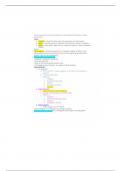OPIOID ANALGESICS, OPIOID ANTAGONISTS, AND NONOPIOID CENTRALLY ACTING
ANALGESICS
Terms:
1. Analgesic→ drug that relieves pain w/o causing loss of consciousness
2. Opioid→ any drug, natural or synthetic, that has actions similar to morphine
3. Opiate→ more specific; applies only to compounds present in opium (morphine,
codeine)
Review:
Partial agonist→ drug that produces low to moderate receptor activation when
administered alone but will block the actions of a full agonist drug when paired
together (agonistic and antagonistic)
-Endogenous Opioid Peptides (3)
-enkephalins, endorphins, dynorphins
-opioid like properties
-found in CNS and peripheral nervous tissue
-act through all opioid receptors: mu, kappa, and delta receptors
Opioid Receptors:
a. Most important→ opioid analgesics act primarily by activating mu
receptors
b. r/t physical dependence
c. Responses
i. Analgesia
ii. Respiratory depression
iii. Sedation
iv. Decreased GI motility
v. Euphoria
a. Weak activation by opioid analgesics
b. Possibly underlying psychotomimetic effects
c. Responses
i. Analgesia
ii. Some respiratory depression
iii. Sedation
iv. Decreased GI motility
a. Opioid analgesics do not interact
*opioid analgesics→ act through mu and kappa receptors
*endogenous opioid peptides→ act through all three receptors (including delta)
,Drugs That Act At Opioid Receptors:
1. Pure Opioid Agonists
a. Activate mu and kappa receptors
b. Produce analgesia, euphoria, sedation, respiratory depression, physical
dependence, constipation
c. Two types:
i. Strong opioid agonists
1. MORPHINE
ii. Moderate to strong opioid agonists
1. CODEINE
2. Agonist-Antagonist Opioids
a. 4 available (pentazocine, nalbuphine, buprenorphine, butorphanol)
b. Activate mu and kappa receptors
c. When administered alone→ ANALGESIA
d. When administered w/ pure opioid agonist→ ANTAGONIZE ANALGESIA
e. prototype→ Pentazocine (talwin)
3. Pure Opioid Antagonists
a. Act as antagonists at mu and kappa receptors
b. Do not produce effects of opioids
c. Clinical use→ reversal of respiratory and CNS depression caused by
overdose of opioid agonist
d. methylnaltrexone→ reverses opioid induced constipation
e. prototype→ Naloxone (narcan)
Prototype for strong opioid analgesic
● Mimics actions of endogenous opioid peptides, primarily at mu receptors
● Principle indication→ relief of moderate to severe pain
● Relieves pain w/o affecting other senses/ causing loss of consciousness
● More effective against dull, constant pain than against sharp, intermittent
pain; sharp pain can be relieved by higher doses
● Indicated for postop pain, preop sedation and anxiety, labor/delivery pain,
chronic pain caused by cancer
● Not first line for pain of MI, pain of dyspnea assoc. w/ left ventricular failure
and pulmonary edema
● Pharmacological effects→
○ analgesia, sedation, euphoria, drowsiness, mental clouding, reduced
anxiety, increased sense of well-being
● Pharmacological Effects Due to Actions at the CNS and Periphery
○ Respiratory suppression
, ○ Bowel motility suppression→ constipation
○ Cough suppression
○ Urinary retention
○ Orthostatic hypotension
○ Biliary colic
■ Gallstone attack
○ Emesis
○ Miosis
■ Contraction of the pupil
● Opioid peptides and morphine like drugs affect regions of the brain and spinal
cord associated with perception of pain
● Tolerance and physical dependence can occur with prolonged use
CROSS TOLERANCE→
● Subjects rendered tolerant to analgesia form morphine-like drugs show
cross-tolerance to analgesia from opioid peptides
● The analgesia effects of opioid peptides and morphine-like drugs can both be
blocked by the same antagonist→ naloxone
ADVERSE EFFECTS→
●
○ MOST SERIOUS ADVERSE EFFECT
○ Death from overdose almost always from resp. depression
○ Through activation of mu receptors; kappa receptors also contribute
○ Time of respiratory depression correlates with route of
administration→
○ IV Onset: 7 minutes
○ IM Onset: 30 minutes
○ SubQ Onset: 90 minutes
○ Spinal injection Onset:
○ Duration of all respiratory depression: 4-5 hours
○ Prolonged use/long term opioid use→ tolerance to resp. depression
○ When administered at therapeutic doses, opioids rarely cause
significant respiratory depression
○ Increased by concurrent use of drugs with CNS-depressant actions:
AVOID→
■ Alcohol, Barbiturates, and Benzodiazepines
○
○ RR should be determined before opioid administration
○ w/hold med if RR <12
, ○ caution/close monitoring in very young pts, older adults, pts w asthma,
and emphysema→ these pts are more prone to respiratory
suppression
○ REVERSAL→ naloxone (narcan); opioid antagonist
●
○ Through actions in CNS and GI tract
○ Activation of mu receptors in the gut
○ Drugs suppress propulsive intestinal contractions, intensify non
propulsive contractions, increase the tone of the anal sphincter, and
inhibit secretion of fluids into the intestinal lumen
○ Opioids are highly effective for treating Diarrhea
○ Other occurrences→
○ Fecal impaction, bowel perforation, rectal tearing, hemorrhoids
○ TREATMENT:
■ Physical activity and increase fiber and fluid intake
■ Enemas
■ Prophylactic drug use→ laxatives
● Stimulant laxative
● Senna→ counteract reduced bowel motility
● Docusate (colace) → stool softener
● Polyethylene glycol→ osmotic laxative
■ Prophylactic drugs inadequate→ Rescue Therapy with a strong
osmotic laxative
● Lactulose
● Sodium phosphate
■ No response w/ enema or laxatives→ methylnaltrexone (relistor)
● Oral drug
● Blocks mu receptors at intestine
● Can’t cross BBB→ can’t reverse opioid induced analgesia
●
○ Blunting of the baroreceptor reflex and peripheral dilation: peripheral
arterioles and veins (results from morphine-induced histamine)
○
○ hypotensive drugs can exacerbate opioid-induced hypotension
●
○ Increases tone in bladder, bladder sphincter, and detrusor muscle,
○ Elavates bladder pressure→ sense of urinary urgency
○ Suppression of awareness to bladder stimuli




